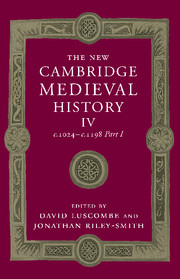Book contents
- Frontmatter
- 1 Introduction
- 2 The Rural Economy and Demographic Growth
- 3 Towns and the Growth of Trade
- 4 Government and Community
- 5 The Development of Law
- 6 Knightly Society
- 7 War, Peace and the Christian Order
- 8 The Structure of the Church, 1024–1073
- 9 Reform and the Church, 1073–1122
- 10 Religious Communities, 1024–1215
- 11 The Institutions of the Church, 1073–1216
- 12 Thought and Learning
- 13 Religion and the Laity
- 14 The Crusades, 1095–1198
- 15 The Eastern Churches
- 16 Muslim Spain and Portugal: Al-Andalus and its Neighbours
- 17 The Jews in Europe and the Mediterranean Basin
- 18 Latin and Vernacular Literature
- 19 Architecture and the Visual Arts
- List of Primary Sources
- Bibliography of secondary works arranged by chapter
- Index
- Frontispiece">
- Plate section"
- References
15 - The Eastern Churches
Published online by Cambridge University Press: 28 March 2008
- Frontmatter
- 1 Introduction
- 2 The Rural Economy and Demographic Growth
- 3 Towns and the Growth of Trade
- 4 Government and Community
- 5 The Development of Law
- 6 Knightly Society
- 7 War, Peace and the Christian Order
- 8 The Structure of the Church, 1024–1073
- 9 Reform and the Church, 1073–1122
- 10 Religious Communities, 1024–1215
- 11 The Institutions of the Church, 1073–1216
- 12 Thought and Learning
- 13 Religion and the Laity
- 14 The Crusades, 1095–1198
- 15 The Eastern Churches
- 16 Muslim Spain and Portugal: Al-Andalus and its Neighbours
- 17 The Jews in Europe and the Mediterranean Basin
- 18 Latin and Vernacular Literature
- 19 Architecture and the Visual Arts
- List of Primary Sources
- Bibliography of secondary works arranged by chapter
- Index
- Frontispiece">
- Plate section"
- References
Summary
the christian churches of the east and the course of history
At the end of the tenth century, the empire of the ‘Abbasid caliphs was everywhere in retreat, and Islam had extended its sway over new regions only in central Asia and on the frontiers of India. In Baghdad the Buyids, and in Egypt and Syria the Fatimids, both Shi‘ites, had seized power. The Byzantine emperors had reconquered Anatolia to beyond the Euphrates and the Orontes.
The Byzantine reconquest had contradictory effects. The ‘great churches’ which had been turned into mosques became cathedrals once more; the number of churches grew, Christian populations were attracted into the reconquered lands, where they escaped the interdicts which they had endured under the Muslims. But the determination of the emperors, especially after Basil II, to impose the Chalcedonian faith on their subjects led to a degree of harassment, even persecution, which often led the Monophysites to seek refuge in Muslim territory.
And the reoccupation was soon jeopardised by the Turkish invasions. These were at first simply raids, in which churches and monasteries were destroyed and priests put to death, before the raiders retired with their booty. However, after the defeat of Romanos Diogenes at Manzikert (1071), the nomadic tribes settled on the pastures, whilst their chiefs occupied the towns. The Seljuks took Nicaea, Konya and Antioch, where the cathedral was turned back into a mosque (1085). Other adventurers occupied other places, taking pains to conciliate the inhabitants; at Shaizar (1082), the first Ibn Munqidh allowed bells to be rung and pigs to be reared. Byzantine governors tried to survive by treating with the Turks; one of them, the Armenian Philaretos, briefly established an extensive dominion, with Marash as its centre.
Keywords
- Type
- Chapter
- Information
- The New Cambridge Medieval History , pp. 564 - 598Publisher: Cambridge University PressPrint publication year: 2004

